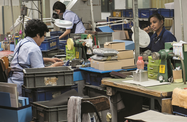Automotive sales in Malaysia slipped down a gear in the second quarter, with both April and May showing a deceleration in the figures, though experts believe activity in the industry will pick up in the latter half of the year after the government unveils a new policy aimed at reducing vehicle price tags.
On June 18 the Malaysian Automotive Association (MAA) report on May vehicle sales showed a 5.4% drop in roll-outs from dealers’ lots compared to the previous month, which had also seen a decline in sales. The report said there had been a 15% dip in trade year-on-year for May, though 2012 had set the bar high, with record sales of 627,753 units for the full year.
While the April and May figures were down on the corresponding months in 2012, overall sales are up 6.2% for the first five months of the year, with just under 260,000 units sold compared to 244,000 over the same period in 2012. This was thanks to a strong performance in the first quarter, the MAA report said. The association noted that, despite uncertainties in the market, it expected year-end sales to top 640,000 units.
One of the key reasons given by analysts for the easing sales figures is a wait-and-see approach adopted by potential car buyers stemming from a promise made by the government in the lead-up to the recent national elections to reduce vehicle prices by 20-30% over the coming five years. This commitment was repeated by Prime Minister Najib Razak at the end of May, three weeks after the polls closed.
While the government has reiterated its promise to lower vehicle costs, it has not made clear how it will do so. The government has said the price cuts will stem from a revision of the National Automotive Policy (NAP), the blueprint for the direction of the industry first drafted in 2009 and amended last year. The NAP aims to boost competitiveness and liberalise the sector in the lead-up to the ASEAN Economic Community launch in 2015, when most of the region’s tariff borders will be removed.
The revised version of the NAP is due to be released some time in the third quarter, after it is reviewed by the Cabinet, by which time producers and dealers hope there will be more clarity over how the cuts will be achieved. The government is reluctant to reduce its automotive taxes at a time when it is trying to narrow the state deficit to 4% in 2013 from last year’s 4.5%, and down to 3% in 2015.
Trade Minister Mustapa Mohamed said on June 24 it was impossible for the government to cut the automotive excise tax, which brings in RM7bn ($2.18bn) to the Treasury annually.
“Our budget is in deficit,” Mustapa said. “If we sacrifice RM7bn, where are we going to find it? At this point of time, it is not something the government is considering.”
If this position is maintained, it would appear to limit options on how to reduce costs for the consumer, though the NAP may open up new avenues and help stimulate sales when released.
Another reason given for the slowdown has been weaker consumer sentiment, a reflection of concerns the Malaysian economy may be cooling. On June 24 OCBC Bank lowered its forecast for economic growth to 5% for this year, a reduction from its earlier estimate of 5.4%. The bank’s projection was in line with that of other analysts, who have tipped GDP expansion of between 4.5% and 5.5%, down from last year’s 5.6%. If the economy does move towards the lower end of market expectations, this may curb Malaysians’ appetite for new vehicles, at least until the position on new tariffs is made clear.
While there may be some uncertainty hovering over the immediate situation of the sector, a number of foreign manufacturers appear to be taking a positive position on its longer-term prospects. Chinese manufacturer Chery has announced it intends to set up a production plant in Malaysia, targeting both the domestic market and using it as a stepping stone into the region. Japanese rival Mazda has also unveiled plans to spend some $30m to expand its production capacity through acquiring an existing facility and constructing a new factory.
Another seeing improved potential in the Malaysian market is German carmaker BMW, which is targeting a 10% increase in sales in 2013 over last year’s 7000 units. The manufacturer reported in early June that sales for the first four months of the year were up by 5%, with hopes a new release of the Mini Cooper would push them even higher.
Some producers, including local manufacturer Proton, moved to lower the prices on some vehicles, though this can be linked to marketing pressures to increase sales and promotional activity leading into Ramadan, the end of which is traditionally linked with higher consumer spending, Malaysia’s carmakers may overall also adopt a wait and see attitude to pricing until after the NAP is rolled out.

